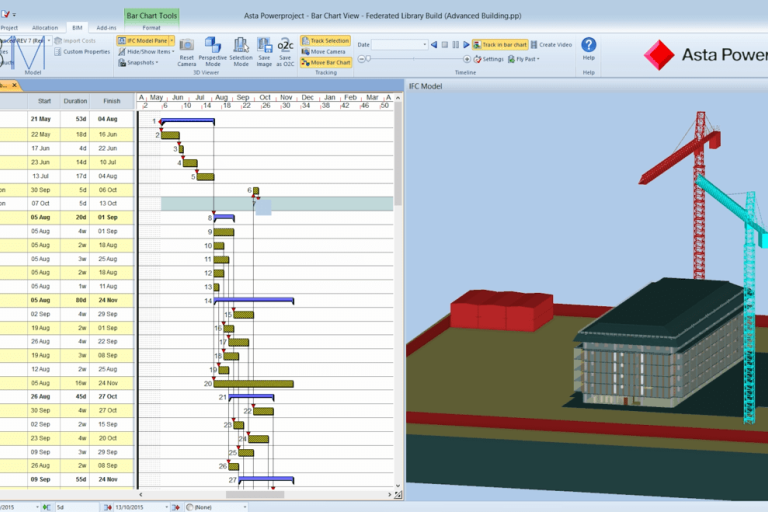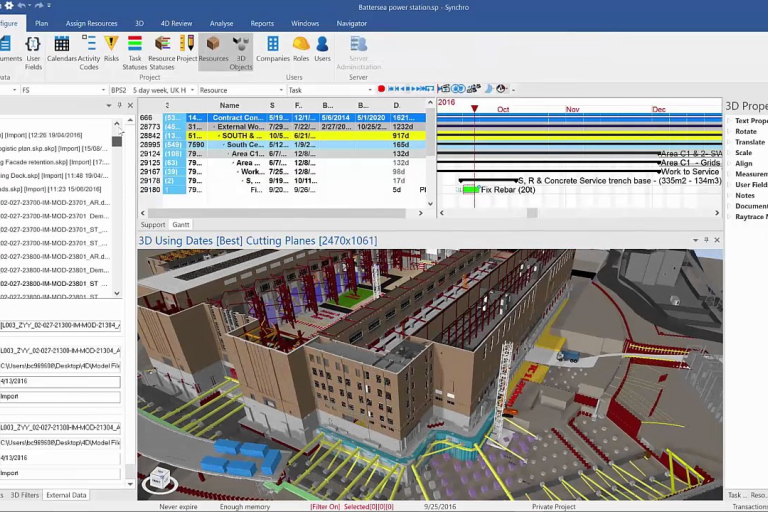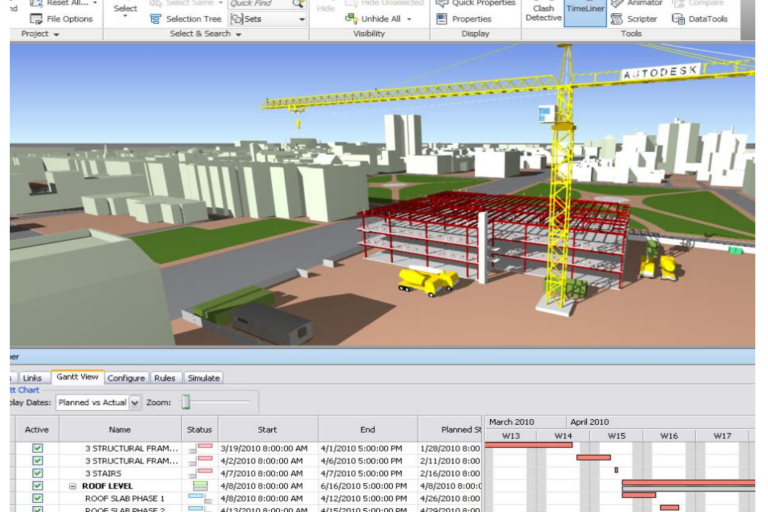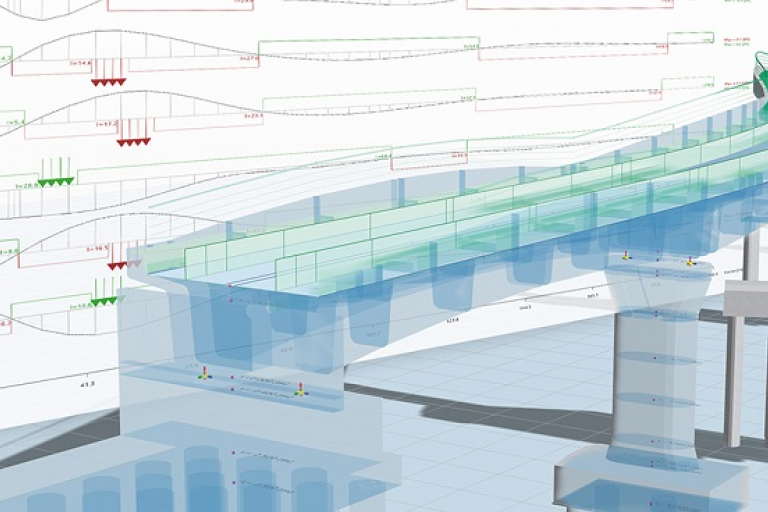Welcome to the world of 4D Building Info Modeling (BIM) and 4D scheduling – they're like super tools for construction projects. Imagine plans not just in 3D but with time included. We'll explore how these tools make projects run smoothly, on time, and more profitable. It's like a cool way of building stuff where time is an important part, and success is like a well-organized and money-making tune.
What is 4D Scheduling?
You know how when you plan something, you consider space, like the dimensions of a room or the layout of a garden? Well, 4D scheduling adds a magical fourth dimension to the mix – time! In construction, time is a big deal. You can have all the right plans, materials, and workers, but if you don't consider when things should happen, chaos might knock on your project's door. That's where 4D scheduling comes in handy. It's like having a time-traveling wizard for your construction plan.

Let's Dive into an Example: Building a Cozy Cottage
Imagine you're building a cozy cottage from the ground up. You've got your blueprints, your team, and all the necessary materials. Now, here's where 4D scheduling works its magic.
Foundation (Month 1-2): The first step is laying the foundation. With 4D scheduling, you not only plan how to pour concrete and build walls but also WHEN to do it. This magical timeline ensures that you're not trying to put up walls before the foundation is ready.
Framing (Month 3-4): Now, you're framing the cottage. Think of it as putting up the skeleton of your future cozy haven. 4D scheduling helps you decide precisely when to start and finish this step, preventing delays or confusion.
Roofing and Windows (Month 5-6): Time to keep the rain out! 4D scheduling ensures that you're not fitting the roof before the walls are ready, making your construction plan as seamless as a well-choreographed dance.
Interior (Month 7-8): Inside matters too! 4D scheduling makes sure your electricians and plumbers aren't stepping on each other's toes – everything happens in the right order.
Finishing Touches (Month 9): Adding the charming details that turn a house into a home. 4D scheduling ensures that your painters aren't waiting around, twiddling their thumbs, while the electricians finish their work.
The Grand Reveal (Month 10): Ta-da! Thanks to 4D scheduling, your cozy cottage is ready for its grand reveal precisely when you planned. No surprises, no delays – just a smoothly executed construction plan.
Read more: BIM 4D Modeling for Construction Scheduling: A Quick Guide
How does 4D Scheduling work?
4D modeling involves three main ingredients:
The 3D Model: This is the foundation, a detailed digital representation of your project, from walls and floors to windows and furniture. Think of it as a super-powered blueprint.
The Schedule: This traditional project plan outlines all the tasks involved in construction, their durations, and dependencies. Imagine a detailed to-do list with deadlines.
The Software: Special software bridges the gap between the 3D model and the schedule. It's like a translator that connects the visual with the chronological.
Bringing it to life:
Now, the fun begins! The software links each task in the schedule to specific elements in the 3D model. This creates a dynamic simulation of your project's construction sequence. Here's how it works:
Phase-by-Phase Visualization: Watch as walls rise, roofs are placed, and windows are installed, all in the correct order. It's like a virtual tour of your project's timeline.
Clash Detection: Imagine trying to put the roof on your house before the walls are up! 4D modeling can identify potential clashes between tasks, like installing pipes before building the walls. This avoids costly rework and delays.
Improved Communication: Share the 4D model with your team, clients, and stakeholders. Everyone can see the plan, understand the sequence, and make informed decisions. It's like having a shared vision board for your project.
Scenario Testing: What if we change the construction order? What if we use different materials? 4D modeling allows you to test different scenarios and see their impact on the timeline and budget. It's like having a crystal ball for your project.

Real Benefits of 4D Scheduling
Building Like a Boss
Remember that friend who always forgets whose turn it is in Monopoly? 4D scheduling eliminates those pesky "who goes next?" moments. It shows everyone, from architects to construction workers, the exact order and timing of each task. Think painting before the roof is on? Not anymore! This clear roadmap keeps everyone on track, avoiding costly delays and grumpy bosses.
Clash of the Titans (Without the Clash)
Imagine trying to fit two puzzle pieces that just don't belong. That's what happens when different parts of a building plan clash in real life. Pipes might run through walls, or doors might open into thin air. Yikes! 4D scheduling lets you spot these clashes before a single brick is laid, saving you time, money, and maybe even a few headaches.
Money Talks, Time Walks
Ever heard of the saying "time is money"? Well, in construction, it's truer than ever. Delays cost a fortune, but 4D scheduling helps you avoid them. By seeing how long each task takes and how they all fit together, you can optimize your workflow, like a well-oiled machine. This means finishing projects on time, staying within budget, and making everyone happy (especially the one holding the purse strings).
Communication Revolution
Building something amazing takes teamwork, and 4D scheduling is the ultimate team player. It's like a shared language everyone understands, from the architect's fancy sketches to the electrician's wiring diagrams. By seeing the big picture together, everyone can anticipate challenges, solve problems before they arise, and make sure the finished product is a masterpiece, not a mess.

4D Models in the Construction Lifecycle
When a project starts, the 4D model is super important at different times. First, in the pre-design stage, it helps decide if the project is doable. The 4D model is like a smart tool for planning, figuring out how to build things, and deciding when to do it. For renovations, it helps decide if tenants need to move out during construction.
Next, in the design development phase, the 4D model keeps being useful. It checks if the design can really be built and figures out the best way to do it. It also plans when to do each part of the construction and when to have people in the building. It's great for explaining the plan to the teams and the people using the space.
Lastly, when contractors want to work on the project, they need to show they can handle the job. The 4D model helps them do that by explaining how they'll manage and do the construction work. Especially if the project is complicated, the 4D model helps everyone understand what's going on. If a contractor really gets how things work, their bid for the job will be more accurate and fair.
Read more: World of BIM Dimensions (3D, 4D, 5D, 6D, 7D, 8D, 9D, 10D)
Factors Affecting 4D Scheduling Implementation
Teamwork Makes the Dream Work
First off, having a super-duper team is crucial. Imagine building a LEGO castle all by yourself – it's possible, but with friends, it's way more fun and efficient! In the construction world, different teams like architects, builders, and planners need to work together like a superhero squad. Good communication and teamwork help 4D models do their job smoothly.
Budget BFFs
Money matters, right? 4D models can be a bit like budget superheroes. They help plan everything so that we don't run out of cash halfway through the project. But here's the catch – they need accurate info about costs and resources. It's like planning a birthday party – you need to know how much cake and balloons you can get with your pocket money.
Learning the 4D ABCs
Lastly, knowing how to use 4D models is like learning a new language. It's not as tricky as alien languages in sci-fi movies, but there's a learning curve. Teams need to understand the ABCs of 4D – how to create, read, and update the models. Think of it like mastering a new dance move – practice makes perfect!

Ready to embrace the future of construction project management? Partner with Harmony AT for unparalleled 4D scheduling services or BIM/ CIM modeling that bring your projects to life before a single brick is laid.
📞 Contact Us Today!
Categories





